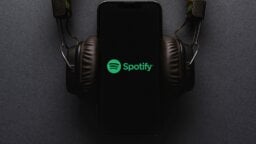Spotify just confirmed that it is indeed launching a newly stratified menu of subscription tiers – including audiobook-only and music-only options.
During the Sweden-headquartered company’s Q1 earnings call yesterday (April 23), co-founder and CEO Daniel Ek addressed his firm’s plans to create more “flexibility” when it comes to subscription plans offered to consumers.
“We want to offer as much flexibility as possible in this next stage of Spotify… because we are at the size where we want to appeal to an even larger base of consumers, to turn to one of our subscription offerings,” Ek said.
“So that obviously means that you’ll see things like, for instance, the audiobook-only tier… you should expect to see a music-only tier as well.”
News of a forthcoming ‘basic’ (aka “music-only”) subscription tier at Spotify – offering just music and podcasts, but not audiobooks – was first broken by Bloomberg earlier this month.
When that tier launches, it will sit alongside a new “Audiobooks Access Tier” (aka: “audiobooks-only”), which recently launched in the US at USD $9.99 per month.
(Subscribers to this tier don’t get Spotify Premium access, though they can access an ad-supported music experience.)
This new menu of plans at Spotify is, of course, at the center of a fiery industry debate right now.
Last week, Spotify confirmed it has begun to categorize its flagship Premium plans as “bundle” subscriptions – bringing together audiobooks and music – rather than plain music streaming subscriptions.
In the eyes of Spotify’s current lawful royalty rate agreement with music publishers in the US, aka Phonorecords IV, this changes things… to the financial detriment of songwriters.
Under the US Copyright Royalty Board’s rules, via Phonorecords IV, streaming services pay out a lesser percentage rate for mechanical royalties for bundled services than for standalone music subscriptions.
This explains why David Israelite, CEO and President of the National Music Publishers’ Association, has accused Spotify of “attacking the very songwriters who make its business possible.”
Bloomberg’s recent report also noted that Spotify is planning to raise the price of its flagship monthly Premium subscription – which currently includes music and 15 hours of audiobooks – in certain key markets, including the US, where it currently costs USD $10.99 per month.
The expectation now working its way around the music business?
When Spotify enacts that price rise later this year in the US (likely from $10.99 per month to $11.99 per month), all of its existing Premium subscribers in the States will be told they are officially subscribing to a pricier “music-plus-audiobooks” tier – and if they want to be ‘demoted’ to Spotify’s new “music-only” or “audiobooks-only” tiers (i.e. “non-bundle” tiers), they’ll need to change their settings manually.
On Spotify’s earnings call on Tuesday (April 23), Daniel Ek and interim Spotify CFO, Ben Kung, didn’t directly address the issue of reduced music royalty payments via this “bundle” re-categorization – despite some questions from analysts that were obviously pointing in that direction.
Asked if Spotify’s royalty payment model meant that increased audiobook consumption would reduce music’s royalty share, Kung said he wouldn’t “get into the specifics,” but he did suggest (maybe) that there is a zero-sum game at play here.
“We do have a concept that I’ll refer to as ‘shifting profit pools,’” said Kung.
“Across our content types, we have all types of cost models. We’ve got variable ones, so that could be anything from revenue shares, per-user models, per-hour models. We also have fixed-cost models. It’s a fairly complex machine and the concept of bundling things together allows us to tap into a strength of ours, which is leaning into this complexity across profit pools and managing it efficiently as we look to meet and serve customer demands where we see it.”
“The concept of bundling things together allows us to tap into a strength of ours, which is leaning into this complexity across profit pools and managing it efficiently…”
Daniel Ek, Spotify
The earnings call came after Spotify reported very solid earnings for Q1, including its highest-ever quarterly operating profit, and the first quarter ever to see a gross margin above $1 billion.
The company reported 239 million paying subscribers in Q1, up 14% YoY, and an increase of 3 million over the previous quarter. Total monthly active users – which includes paying and ad-supported subscribers – reached 615 million, up 19% YoY.
The company posted operating income of €168 million ($182.41 million), for the quarter which it called “a new quarterly high” and attributed to “lower personnel and related costs and marketing spend.” Spotify laid off around 17% of its workforce in December, in what was the company’s third round of job cuts in the prior year.
The company reported a gross profit of €1.004 billion ($1.090 billion) in Q1.
Aside from the new subscription tiers coming to Spotify, here are four other things we learned on the company’s latest earnings call…
1) SPOTIFY NO LONGER considers itself JUST A MUSIC COMPANY, BUT A MULTI-CHANNEL CONTENT COMPANY
At various times during the call, Ek highlighted the idea that Spotify is expanding well beyond being a music streaming service.
That’s hardly breaking news, given its expansion into podcasts, audiobooks, and video years ago, but what’s notable here is that Spotify’s CEO suggested that future subscriber and top-line growth will depend not so much on an increasing number of music listeners on the platform, but rather on increasing the number of consumers of other types of content.
Spotify “isn’t just a sort of one-trick pony anymore, but it is actually multiple verticals working together to provide a consistent, great story around more and more choice for consumers, [which] drives more and more engagement,” Ek said.
“You may come for the music and stay for the audiobooks, and some consumers may come for the podcasts and stay for the audiobooks. [There are] going to be more ways for people to interact with it.”
“[Spotify] isn’t just a sort of one-trick pony anymore, but it is actually multiple verticals working together to provide a consistent, great story around more and more choice for consumers.”
Daniel Ek, Spotify
If Ek is more confident in the idea that Spotify is no longer just a music company, that likely comes from an analysis of data. He noted at one point during the call that more than 25% of Spotify’s user base now engages with audiobooks. Which begs an interesting question for the music industry: How much of Spotify’s impressive increase in paying subscribers over the past year wasn’t about music?
It may be that music rightsholders will need to change the way they think about Spotify. If Ek’s plans come to fruition, it will make more sense to think of Spotify as being akin to YouTube – a place where music can be monetized, but where music is just one aspect of a much broader business.
2) SPOTIFY WANTS TO BEAT TIKTOK ON MUSIC DISCOVERY, AND IT’S PLANNING TO EXPAND SHORT VIDEO CONTENT TO DO IT
The US appears to be inching ever closer towards forcing ByteDance to divest its holdings in TikTok, or see TikTok banned from US app stores.
Asked on the earnings call whether a US TikTok ban would be good for Spotify, Ek declined to “comment on other companies and… their strategy [or] what may happen with their regulatory proceedings.”
But he made it clear he sees TikTok as a competitor, in that the short video platform has become a major focal point of music discovery.
“Short-form music content is a big focus of ours.”
Daniel Ek, Spotify
“We are focused on winning discovery, and we’re going to add as many ways that we can to improve discovery [on] Spotify,” Ek said.
“You saw us in the quarter add music videos. You’re going to see music clips in a bigger way. You can already, today, if you open up the app, start seeing more and more videos on the music side where artists are engaging with fans… in a similar way [to] the Reels product that TikTok did a few years ago.”
He added: “Short-form music content is a big focus of ours.”
Spotify launched a new short-video feature called “Clips” on its platform a little more than a year ago. It also launched a new tool called Countdown Pages, where artists can promote new releases through exclusive video clips, pre-save buttons, and track list previews. The feature also comes with a countdown timer for releases.
“We are all, as an industry, learning about these trends and best practices and trying to improve our products,” Ek said on the earnings call. “That’s what great competition does. It helps [everyone] to improve.”
3) MARKETPLACE WAS A ‘BIG CONTRIBUTOR’ TO SPOTIFY’S RECORD GROSS PROFITS
The key obstacle to Spotify becoming consistently profitable has been the company’s low gross margin, due mainly to the fact that it pays out a large chunk of its revenue to rightsholders.
One aspect of Spotify’s strategy to address this issue is its “two-sided marketplace.” Launched in 2019, it allows artists to pay for their music to be promoted on users’ homepages or within playlists. In effect, it’s a way for Spotify to claw back some of the money it forks over to rightsholders.
Now, it finally seems to be working. In its latest earnings report, Spotify gives partial credit to Marketplace for the 30.2% increase in the gross margin on the Premium side of its business. (Another key factor here was cost reductions, not least of which have been the successive rounds of job cuts the company has implemented).
“We feel really confident about the gross margin trajectory and the sequential momentum we have,. So consider this a real trend and not just a function of one-offs.”
Ben Kung, Spotify
On the earnings call, Ek called Marketplace a “big contributor” to the company’s improved margins, and added that all the Marketplace products are “growing nicely.”
Interim CFO Ben Kung added that the jump in the company’s overall gross margin improvement in Q1 wasn’t a one-time event.
“We feel really confident about the gross margin trajectory and the sequential momentum we have,” Kung said. “So consider this a real trend and not just a function of one-offs.”
Kung attributed the success to “a lot of moving parts” including “nonmusic, music, Marketplace, to name a few of the major areas. We also had movements in other cost of revenue, such as continued favorability with cloud costs… So there are a bunch of things driving the upside.”
4) SPOTIFY EXPECTS its PODCASTS business TO BECOME PROFITABLE THIS YEAR
Back in 2018, Spotify committed to spending $500 million to develop podcasts on its platform. By 2020, that number had grown to $800 million, and by 2022, it had spent $1.2 billion on non-music content, including a reported $100 million-plus for exclusive rights to The Joe Rogan Experience and a reported $25 million for a podcast from Barack and Michelle Obama’s media company Higher Ground.
So it’s no doubt welcome news to hear that the company’s bet on podcasts is about to pay off.
“This year, we expect profitability for the podcast segment,” Ek said on the earnings call.
No doubt, this has something to do with Spotify’s new-found religion: Cost reduction. In June of last year, the company cut 200 jobs as part of its efforts to reorganize its podcast division, which also included merging two of its podcast studios, Parcast and Gimlet, into “a renewed Spotify Studios operation.”
Ek added on the earnings call that the improvement in podcasts is “adding” to the company’s improved gross margin, having been ”a bit of a drag” on it last year.
“So… it is really a new Spotify you’re seeing, where we are being relentlessly resourceful on all of our costs, and in driving improvements in efficiency on all our different drivers that are adding up to this gross margin number,” Ek said.Music Business Worldwide




